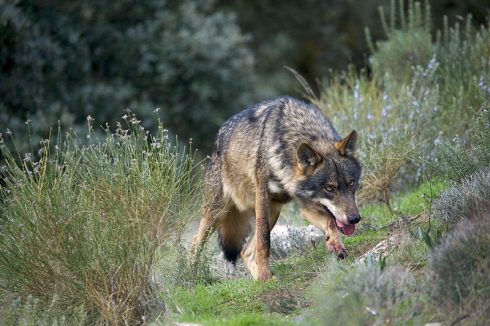Clive Muir and Sue Eatock investigate the carob tree, whose seeds are valued by jewellers and goldsmiths
THE carob is a long living tree that can obtain a height of around 12 to 15 metres and extends to a wide canopy. It is native to the Eastern Mediterranean area where it thrives in arid conditions but is now cultivated commercially in warm climates as the pods have an important economic value, known for at least 4,000 years.
Known in Spanish as algarrobo, the carob is an evergreen with oval glossy green leaves and a short wide trunk, which on mature specimens is rough and gnarled. The scientific name of the tree, Ceratonia siliqua, derives from the Greek word keras, meaning horn, and the Latin siliqua meaning pod, alluding to the hardness and shape of the pod.
It is a member of the botanical Fabaceae family of plants (leguminous beans and peas).
Carob flowers and fruit grow out of older branches, twigs and even the trunk of the trees – a botanical phenomenon known as cauliflory. The flowers are insignificant as they have no petals (similar to catkins) and are green/yellow or red in colour, these being mostly on separate male and female trees. The pollen from the male flower needs to be distributed by insects to the female flowers from which the beans then develop. The carob tree flowers in September and October with the developing carob pods slowly gaining the appearance of green broad beans. It takes 11 months to develop into a pod that is flattish, shiny brown and around 15 to 20 centimetres long.
The carob produces little fruit until it reaches 15 years old, although it can live for 100 years with a large tree producing one tonne of beans in a harvest. It is now grown commercially in Spain, Portugal, France, Italy, Africa, California, Arizona, Mexico, South America and Australia,
A long hot summer ensures a plentiful crop of the long beans, which are collected by hand from the tree or later from the ground after they fall. Many small-holdings still have a carob tree to give a supply of fodder to their animals through the winter. They are also gathered and taken to some agricultural co-operatives for bulk re-sale.
The seed pod or bean is thick and glossy from a healthy tree. The interior consists of multiple, disc-like, brown seeds set in a sweet pulp. The washed carob pod is kibbled (coarsely ground) to separate the pod from the 5 to 15 seeds.
When the seeds are removed, the pod is further kibbled to various grades for animal feed and even more finely to produce chocolate-like flour that is used in all sorts of carob preparations.
The seeds are ground down with the resulting powder being used as a natural additive. This contains galactomannon, a commercially valuable carbohydrate that is used as a thickener, emulsifier and stabilizer in many products. It is known as E410 (LBG locust bean gum) and incorporated into foods such as ice-creams / cream cheeses / sauces etc to help thicken them while keeping the mixture smooth. It has a similar use in the production of textiles, paints and to lesser extent paper products. Spain is the biggest producer of LBG. There are only a dozen or so production plants creating the gum, which has a worldwide demand of around 35,000 tonnes of carob seed per year.
The sweet carob pulp taken from the pod is ground into a powder which is gaining popularity as a healthy alternative to chocolate as it is free from the stimulants caffeine and theobromine. Carob products contain substantially less sugar than their chocolate counterparts as it is already naturally sweet. Carob powder, found mostly in health food shops, can be substituted for cocoa powder in any recipe. This substitute is often used to create snack bars for diabetics as they require less sugar.
It is popularly believed that John the Baptist, later known as Saint John, sustained himself while travelling in the wilderness by eating carob pods (the debate is as to whether it was locust beans as they are sometimes called or the insects). This gave rise to another common name for the Carob tree – Saint John’s Bread.
The seeds within the pods are of a uniform shape and size, so much so that it is thought they are the original standard weight for gemstones used by jewelers and goldsmiths. Carob seeds weigh between 197 and 216 milligrams, 200 milligrams is the standardized “carat” weight of diamonds brought in at the beginning of the 20th century.
As well as using the bean crop in agro-forestry as detailed above there are many other reasons for planting carobs.
The Carob tree is fire resistant and has few disease problems. The timber can be turned and carved, used for fuel and also for making slow burning charcoal. Planted at a perimeter they make good windbreaks and shelter for livestock as well as creating perfect habitats for wildlife.
The strong root system can be invasive so do not plant directly along side buildings. Being evergreen it will shed small amounts of leaf debris throughout the year.
Clive and Sue launched wildsideholidays.com as an advertising medium for ethically-minded nature holiday businesses in Spain. The aim is to provide an internet site on which people searching for this type of holiday can easily fi nd what they are looking for. Together with iberianature.com, wildside holidays also run the iberianature forum (www.iberianatureforum.com) – the best online resource for learning about the nature of Iberia.








Very informative article,
a lot of health food shops sell biscuits and cakes using Carob meal – wonderful taste – do try.